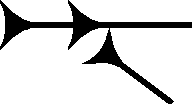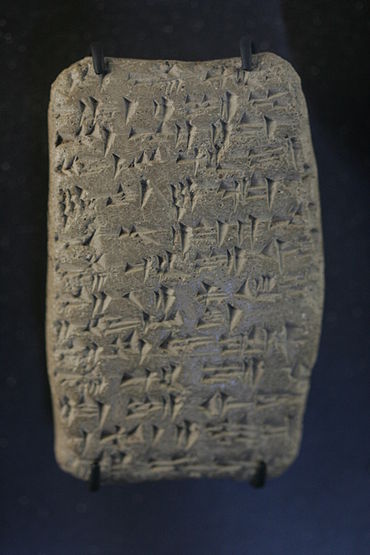Qut


In Line 6, 2nd character from left, for am-qut, (Akkadian language, maqātu, "to fall, to happen",[1] I bow down) ; text reads left-to-right.
(am-qut).


(high resolution, expandible photo)
The cuneiform qut sign, (also qud, aspirated 't', unaspirated 'd') sign is found in both the 14th century BC Amarna letters and the Epic of Gilgamesh. It is a multi-use sign with 9 syllabic/alphabetic uses in the Epic of Gilgamesh; in the Amarna letters it is extremely common in the prostration formula, typical first paragraph of a letter, saying typically: "7 and 7 times, I bow down" (to the Pharaoh, when addressed to the Pharaoh); a small group of Amarna letters are addressed to a different distinct personage in Egypt, under the Pharaoh.
In the Epic of Gilgamesh, the sign is used for many syllabic meanings, as well as two Sumerograms, as follows:[2]
- has
- haṣ
- kut
- qud
- qut
- šel
- šil
- tar
- ṭar
- SILA, "street Sumerogram"
- TAR, for Goddess Ishtar's name, DIŠ.TAR
The usage numbers for the sign are as follows in the Epic:[3] has-(2), haṣ-(7), kut-(6), qud-(8), qut-(27), šel-(1), šil-(4), tar-(16), ṭar-(9), SILA-(3), for Akkadian language "sūqu", 'street',[4] TAR-(17), exclusively for Ištar's name.
Usage, letter EA 364
For
The following is Rainey's (1970) English language, mostly sequential line-by-line translation, and sign characters, up to line 11:[6]
- (1) "To the king, my lord, (2) thus (speaks) Tahmassi, messenger envoy)
- (1) "Tahmassi) (14) ...."
Lines 7 and 11, have the repetition, "King-Lord-mine" from Line 1 (LUGAL-EN-ia, "Šarri-Bēli-ia" for the Akkadian).
Akkadian maqātu, "to fall", "to happen"
The phrase: ...7 and 7 times, "I bow (down)".... is extremely prominent in the Amarna letters, and especially from the letters from the Canannite city-states. The Akkadian language word is "maqātu",[7] to fall, to happen, etc., and has various spellings requiring an m, q-(or equivalent (k)), and t. One of the commonest spellings are the two cuneiform signs am-qut. ![]()
![]()
References
- ^ Parpola, 1971. The Standard Babylonian Epic of Gilgamesh, Glossary, pp. 119-145, maqātu, to fall, to happen, p. 131.
- ^ Parpola, 1971. The Standard Babylonian Epic of Gilgamesh, Sign List, pp. 155-165, no. 012, p. 155.
- ^ Parpola, 1971. The Standard Babylonian Epic of Gilgamesh, Sign List, pp. 155-165, no. 012, p. 155.
- ^ Parpola, 1971. The Standard Babylonian Epic of Gilgamesh, Glossary, pp. 119-145, sūqu, p. 139.
- Ashtartuto the King, pp. 22-23.
- Ashtartuto the King, pp. 22-23.
- ^ Parpola, 1971. The Standard Babylonian Epic of Gilgamesh, Glossary, pp. 119-145, maqātu, to fall, to happen, p. 131.
- ISBN 0-8018-6715-0)
- Parpola, 1971. The Standard Babylonian Epic of Gilgamesh, Parpola, Simo, Neo-Assyrian Text Corpus Project, c 1997, Tablet I thru Tablet XII, Index of Names, Sign List, and Glossary-(pp. 119–145), 165 pages.
- Rainey, 1970. El Amarna Tablets, 359-379, Anson F. Rainey, (AOAT 8, Alter Orient Altes Testament 8, Kevelaer and Neukirchen -Vluyen), 1970, 107 pages.
